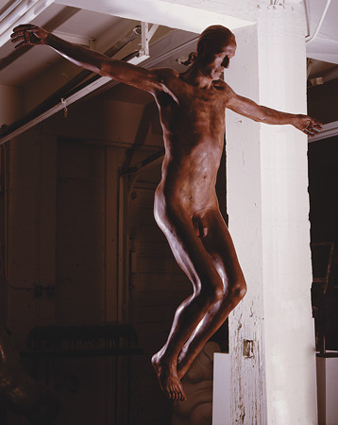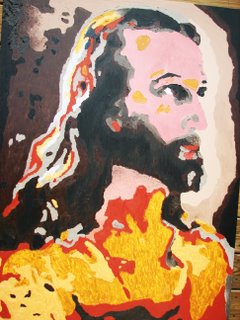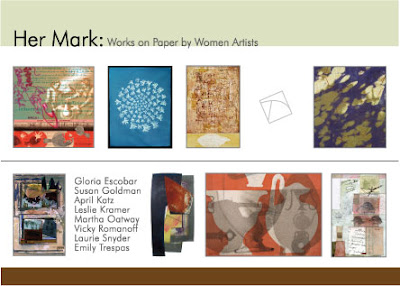Posted by Leslie Holt on April 4th, 2007

Ok, I couldn’t resist.
Not only do I love chocolate, but I love good art controversy. Artist Cosimo Cavallaro has created 6-foot Jesus statue made out of milk chocolate and called it “My Sweet Lord” or “Sweet Jesus” that was to be put on display this Holy Week in an art gallery attached to the Roger Smith Hotel in New York City. The gallery director ended up pulling the piece, due to pressure from the public and the Catholic Archdiosese. more… »
Posted by Sunil Gangadharan on March 29th, 2007
I was recently asked to loan one of my paintings for a company art lobby and I went into a frenzied state of deciding the right frame for the picture. I searched for about a week without too much success until I was lucky to chance on a dark wood frame. One of these days I will have to lug the painting, frame and all to the corporate building where it will hang for a year.
This set me thinking on the following:
-Do you decide beforehand the ‘right’ frame (that in your opinion is the most suitable one for a particular painting/photo) or do you ask your client for suggestions or is it a mixture of both?
-Is the whole framing thing passé now? I was in a couple of Chelsea galleries last week and not a single oil was framed (the artists did not even bother to hide the fact that the edges were dirty from all the wear and tear)? Is that a new trend?
I would be very interested in your thoughts…

Karl always asked me about the relative size of my paintings (the internet does not do a proper job of projecting the size..) This is a picture of my three year old son posing next a couple of my ‘unframed’ paintings.
Posted by David on March 28th, 2007
Posted by Sunil Gangadharan on March 22nd, 2007
-quality(75))
Title: Odi Profanum Vulgus
Medium: Oil on canvas
Size: 4 feet high X 3 feet wide
The technique used here involved the initial manipulation of a digital photographic image described in some detail here. After I achieved the desired, I proceeded to work on the canvas using oils (mostly primary colors) poured onto the brush directly from the tube (using the digitally transformed image as a guide). Very little mixing. Any mixing whatsoever was on the canvas directly. Finished the background by using a drip of cadmium red deep with linseed to improve flowing.
The image used was that of George Walker Bush.
Posted by Sunil Gangadharan on March 15th, 2007
Our everyday lives are bombarded by images and in a majority of cases what we see is not really the end of the story, it is what we perceive of the seen object that really tells us the story. People who suffer from a form of visual agnosia (called propagnosia – a condition associated with deficits in the right temporal lobe damage manifesting an inability to consciously recognize faces) suffer a remarkable problem in not being able to cognitively distil the details that they ‘see’ in every day life and hence perceive even the most mundane items to be things completely different. Famous among this is the case of Dr. P from Oliver Sachs’s book “The Man who mistook his wife for a Hat and other clinical tales” who actually mistook his wife for a hat and proceeded to wear ‘her’ and even mistook the author of the book for a grandfather clock. The man clearly perceived the world to be something completely different from what the rest of us saw and experienced as reality. Cases of perception being different from reality are also seen in religious symbols. I remember being in India at the time when stone idols of a Hindu god was purportedly drinking milk offered by devotees. I also remember reading the news where enterprising people saw images of their holy representatives on grilled cheese sandwiches. I also know that the same grilled cheese sandwich has been bought on e-bay for thousands of dollars. In fact Wikipedia has an interesting collection of such religious simulacra here. Reading reports of grilled cheese sandwiches and the like prompted me to create the following painting as a commentary on this phenomenon.

“Mugshots on grilled cheese sandwiches – new trends in religiosity” : Oil on canvas (3ft X 4ft)
How often do you use symbolism in your art? How do you manifest your art with a deeper agenda than what is outwardly seen and how often do people actually understand the symbology employed? How often do you have to explain your symbols with a descriptive title rather than the art ‘speak for itself’’?
Posted by Arthur Whitman on March 14th, 2007

The Ink Shop is one of Ithaca’s best and most consistent art exhibition venues. The level of work shown is generally high. Shows of prints by members or invited artists – as well as the occasional traveling exhibition – are almost always put together with evident thought and care. The latest show, curated the inimitable Christa Wolf (a member) is no exception. Entitled “Her Mark: Works on Paper by Women Artists,” it attempts to invoke the spirit of the female artists’ collectives of the seventies. In a welcome move, the selection of works goes beyond traditional printmaking to incorporate painting, drawing and collage.
More.
Posted by Sunil Gangadharan on March 1st, 2007
I was recently reading a book by neuroscientist V.S. Ramachandran where he argues that Chola bronzes from ancient India were mocked at by the Victorian Englishmen as artistically primitive and unrealistic. They were unrealistic in the sense that the waist was too narrow, hips too wide and their breasts too large. They in fact decided that art like this was not art at all and labeled it primitive art. Professor Ramachandran goes on to say that some of the Victorians labeled the art thus based on prevailing standards of Western art (some of which was rooted in realism and stemmed from classical Greek and Renaissance art).
more… »



-quality(75))

